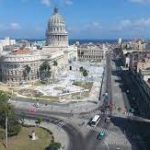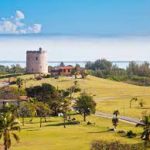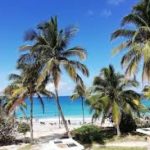LA CACERÍA POR EL “CHÉ” GUEVARA Y SU CONVERSIÓN EN UN PRODUCTO COMERCIAL. PHOTOS
Cuando Guevara fue asumido por los informes el estar en Bolivia, Estados Unidos envió un equipo del ejército de fuerzas especiales Green Beret de 16-hombres para crear y formar a una compañía elite boliviana de Ranger. Con las tropas Estados Unidos sumergidos totalmente en Vietnam del sur, la Casa Blanca se negó a que los boinas verdes acompañaran a los bolivianos en el combate contra el grupo de Guevara. Los bolivianos tuvieron que ser entrenados rápidamente.
Entre otros pusieron inmediatamente a Gustavo Villoldo y otros Cubanos-Americanos sobre la pista. Villoldo fué el agente de la CIA que comenzó la cacería del Che. Sus órdenes de la CIA fueron el localizar al Che, recordó Villoldo, ” pero mi intención era llegar a él, “vivo o muerto”.
Fue Villoldo quien le fue acosando desde el Caribe hasta África y en América Latina para vengar la muerte de su padre y luchar contra la marcha comunista de Castro.
Fue Villoldo quien tuvo que cruzar un río en crecida de noche para infiltrarse en sangrienta guerra civil en la República Dominicana para asegurarse que los rumores de que el Che estaba allí fuesen ciertos. El argentino no fue alli nunca encontrado. Fue Villoldo quien lideró a un grupo de agentes de la CIA cubano-estadounidense en el Congo más tarde ese año, apenas para no alcanzar al Che cuando huyó a Tanzania con 120 otros cubanos después de que las fuerzas de los rebeldes fue aplastada por el Gobierno.
El Che Guevara fue escondido durante meses después en el Congo, lamiendo sus heridas en su psiquis de lucha y mientras busscaba otro país donde él podría intentar de nuevo los frutos de la subversión. Después de una visita a Cuba para ver a su familia, se estableció que fuera a Bolivia.
EL CHE EN BOLIVIA…
Duró apenas 12 meses en las selvas de Bolivia, los ocho primeros oculto mientras preparaba su campaña de guerrilla, los cuatro últimos huyendo de un batallón de Rangers del ejército boliviano, entrenados por boinas verdes del Ejercito de Estados Unidos. Un oficial de la CIA que dirigió la misión de Bolivia ha confirmado que Villoldo era el “agente de plomo en el campo”.
Villoldo llevó las credenciales del ejército boliviano quien lo identificaban como el capitán Eduardo González. Vestían fatigas del ejército boliviano y Villoldo fue tan discreto que varios oficiales bolivianos que trabajaron con él durante varias semanas nunca llegaron a darse cuenta que era un hombre de la CIA.
Entre sus tareas: evaluar información desde el interrogatorio del socialista francés Regis Debray, quien había escrito un libro brillante en la ideología de la guerrilla de Castro. Debray había sido capturado después de visitar a Che en las selvas bolivianas. En una oscura disputa que continúa hasta nuestros días, la familia del Che ha acusado a Debray de traicionarle. Debray lo niega. Villoldo, utilizando la jerga cubana para alguien que confiesa todos, dijo: “habló hasta por los codos”.
Che, 39, fue herido y capturado durante un tiroteo de selva el 08 de octubre de 1967. Fue ejecutado por dos Rangers bolivianos al día siguiente en la escuela de ladrillos de barro en el poblado de La Higuera, por órdenes del dictador militar de Bolivia, René Barrientos.
“En ningún momento ni yo ni la CIA tuvimos voz en la ejecución del Che”, dijo Villoldo. “Esa fue una decisión boliviana”.
Cadáver del Che fue atado a uno de los lados del helicóptero del ejército ese 9 de octubre y trasladado a la cercana ciudad de Vallegrande, donde los Rangers habían establecido una base cerca de una pista de aterrizaje. El cuerpo fue mostrado a los campesinos y periodistas en las siguientes 24 horas. El cuerpo fue colocado en una camilla encima de un lavabo de cemento detrás del Hospital ‘Nuestro Señor de Malta’ realmente en un local adjunto al hospital al fondo y … a continuación, desapareció por 30 años.
TRAS LA RECUPERACION DE LOS RESTOS DEL CHE GUEVARA…
Recuperar los restos del Che fue un triunfo de propaganda de Castro, cuya ideología se aquiloso desde el colapso del bloque soviético.
Fue, literalmente, el cartel que sirvio a Fidel Castro. El Che fue un médico asmático, argentino, quien se unió a Castro en la guerra contra la dictadura de Batista, entonces rechazó la ortodoxia Soviética y dio su vida tratando de exportar una ideología que consideraba más humanitario que comunista.
” El Che se ha convertido en un símbolo universal, multigeneracional de los años 60, como los Beatles, un hombre político suficiente para capturar la política de los tiempos en un sentido amplio sin empantanados en el tema de la guerra fría,” dijo Jorge Castañeda, un mexicano que han creado uno de tres biografías de publicados este año. Pero la historia del Che es todo sobre dinero, demasiado. Cuba comprada 10.000 relojes Swatch suizos hicieron llevar revestido de boina y con barba visage y vendió en las boutiques de la Habana. El ex Ministro de cultura Armando Hart fue autor de un CD-ROM multimedia sobre el Che, un precio de $60.
Historiador de la música de la Habana Santiago Felui ha reunido una antología de 135 canciones sobre el Che, que pondrán a la venta en octubre. Felui dijo que incluirán las canciones tradicionales ritmos cubanos así como rock y blues y algunos cuyas letras son ” críticas de aquellos que han mal y vulgarized la imagen del Che”.
Tal vez quiere decir los vendedores de calle cubano que ofrecen la imagen del Che de turistas sobre todo de tallas en madera para martillado hojas de uva de mar de cuero y incluso seco con algunas de sus frases famosas.
Es dudoso que significa llaveros, carteles y camisetas con la imagen del Che siempre se venden en las tiendas de Gobierno cubano en un pop $6 a $10.
Cuba señaló a la línea en comercializar la imagen del Che el año pasado, pasando después de una cervecera británica que brevemente fabricado una cerveza ” Che” llevando su imagen y el eslogan cautivante, ” prohibido en Estados Unidos. Debe ser bueno.”
Por supuesto ciertos artefactos–la auténtica como fusiles viejos oxidados, mochilas y amarillento fotografías encontradas en Bolivia y tranquilamente traída a Cuba por agentes cubanos durante años–no puede ser masivo producido. Pero aún pueden ser explotadas.
THE HUNT FOR “CHÉ” GUEVARA AND ITS CONVERSION INTO A COMMERCIAL PRODUCT. PHOTOS
When Guevara was reportedly assumed to be in Bolivia, the United States sent a 16-man Army Green Beret special forces team to create and train an elite Bolivian Ranger company. With the United States troops totally submerged in South Vietnam, the White House refused to allow the Green Berets to accompany the Bolivians in the fight against the Guevara group. The Bolivians had to be trained quickly.
Among others, they immediately put Gustavo Villoldo and other Cuban-Americans on the track. Villoldo was the CIA agent who began the hunt for Che. His orders from the CIA were to locate Che, Villoldo recalled, ”but my intention was to get to him, “dead or alive”.
It was Villoldo who harassed him from the Caribbean to Africa and Latin America to avenge the death of his father and fight against Castro’s communist march.
It was Villoldo who had to cross a flooding river at night to infiltrate the bloody civil war in the Dominican Republic to make sure the rumors that Che was there were true. The Argentine was never found there. Villoldo led a group of Cuban-American CIA operatives in the Congo later that year, barely missing Che when he fled to Tanzania with 120 other Cubans after the government crushed rebel forces. .
Che Guevara hidden for months afterward in the Congo, licking the wounds of his fighting psyche as he searched for another country where he could once again try the fruits of subversion. After a visit to Cuba to see his family, he was set to go to Bolivia.
THE CHE IN BOLIVIA…
He lasted just 12 months in the jungles of Bolivia, the first eight hidden while preparing his guerrilla campaign, the last four fleeing from a battalion of Bolivian Army Rangers, trained by green berets from the United States Army. A CIA officer who led the Bolivian mission has confirmed that Villoldo was the “lead agent in the field.”
Villoldo carried the credentials of the Bolivian army who identified him as Captain Eduardo González. They wore Bolivian army fatigues and Villoldo was so discreet that several Bolivian officers who worked with him for several weeks never realized he was a CIA man.
Among his assignments: evaluating information from the interrogation of French socialist Regis Debray, who had written a brilliant book on Castro’s guerrilla ideology. Debray had been captured after visiting Che in the Bolivian jungles. In a dark dispute that continues to this day, Che’s family has accused Debray of betraying him. Debray denies it. Villoldo, using the Cuban slang for someone who confesses everyone, said: “he talked up his elbows.”
Che, 39, was wounded and captured during a jungle firefight on October 8, 1967. He was executed by two Bolivian Rangers the next day at the mud-brick school in the town of La Higuera, on the orders of Bolivia’s military dictator, Rene Barrientos.
“At no time did I or the CIA have a say in Che’s execution,” Villoldo said. “That was a Bolivian decision.”
Che’s body was strapped to the side of an army helicopter on October 9 and flown to the nearby town of Vallegrande, where the Rangers had established a base near an airstrip. The body was shown to the peasants and journalists in the following 24 hours. The body was placed on a stretcher on top of a concrete sink behind the ‘Our Lord of Malta’ Hospital, actually in a room attached to the hospital in the background and… then it disappeared for 30 years.
AFTER THE RECOVERY OF THE REMAINS OF CHE GUEVARA…
Recovering Che’s remains was a propaganda triumph for Castro, whose ideology has been strengthened since the collapse of the Soviet bloc.
It was, literally, the cartel that served Fidel Castro. Che was an asthmatic Argentine doctor who joined Castro in the war against the Batista dictatorship, then rejected Soviet orthodoxy and gave his life trying to export an ideology that he considered more humanitarian than communist.
“Che has become a universal, multigenerational symbol of the 1960s, like the Beatles, a political man enough to capture the politics of the times in a broad sense without getting bogged down in the Cold War issue,” said Jorge Castañeda, a Mexican who has created one of three biographies published this year. But the Che story is all about money, too much. Cuba bought 10,000 Swiss Swatch watches made to wear wearing berets and beard visages and sold in Havana boutiques. Former Minister of Culture Armando Hart authored a multimedia CD-ROM on Che, priced at $60.
Havana music historian Santiago Felui has put together an anthology of 135 songs about Che, which will be released in October. Felui said that they will include traditional songs, Cuban rhythms, rock and blues, and some whose lyrics are “critical of those who have wronged and vulgarized the image of Che.”
Perhaps he means the Cuban street vendors who offer tourists the image of Che especially from wood carvings to hammered leather and even dry sea grape leaves with some of his famous phrases.
It is doubtful that means key chains, posters, and T-shirts with Che’s image are always sold in Cuban government stores at a pop $6 to $10.
Cuba drew the line on marketing Che’s image last year, going after a British brewery that briefly brewed a “Che” beer bearing his image and the captivating slogan, “Banned in the United States.” It must be good.”
Of course, certain artifacts–the real thing like rusty old rifles, backpacks, and yellowing photographs found in Bolivia and quietly brought to Cuba by Cuban agents for years–cannot be mass-produced. But they can still be exploited.
Agencies/ Wiki/ ElHerald/ Tamayo/ Villoldo/ Extractos/ Excerpts/ Internet Photos/ Arnoldo Varona/ www.TheCubanHistory.com
THE CUBAN HISTORY, HOLLYWOOD.












